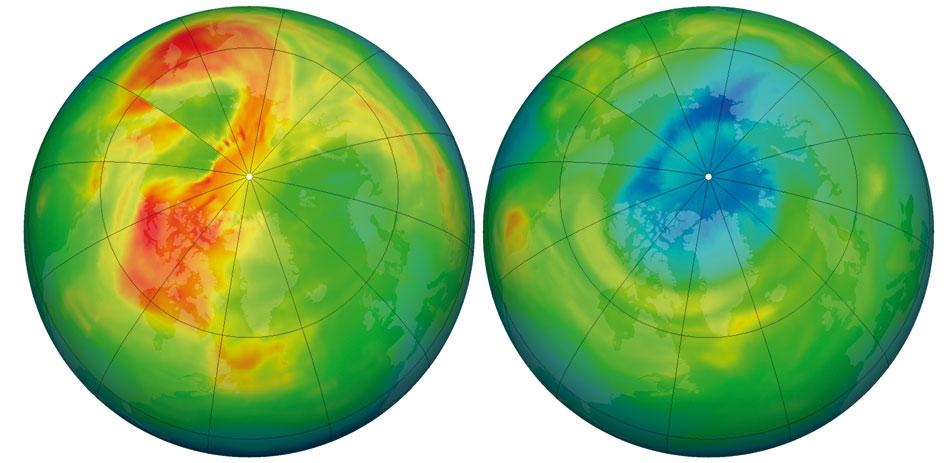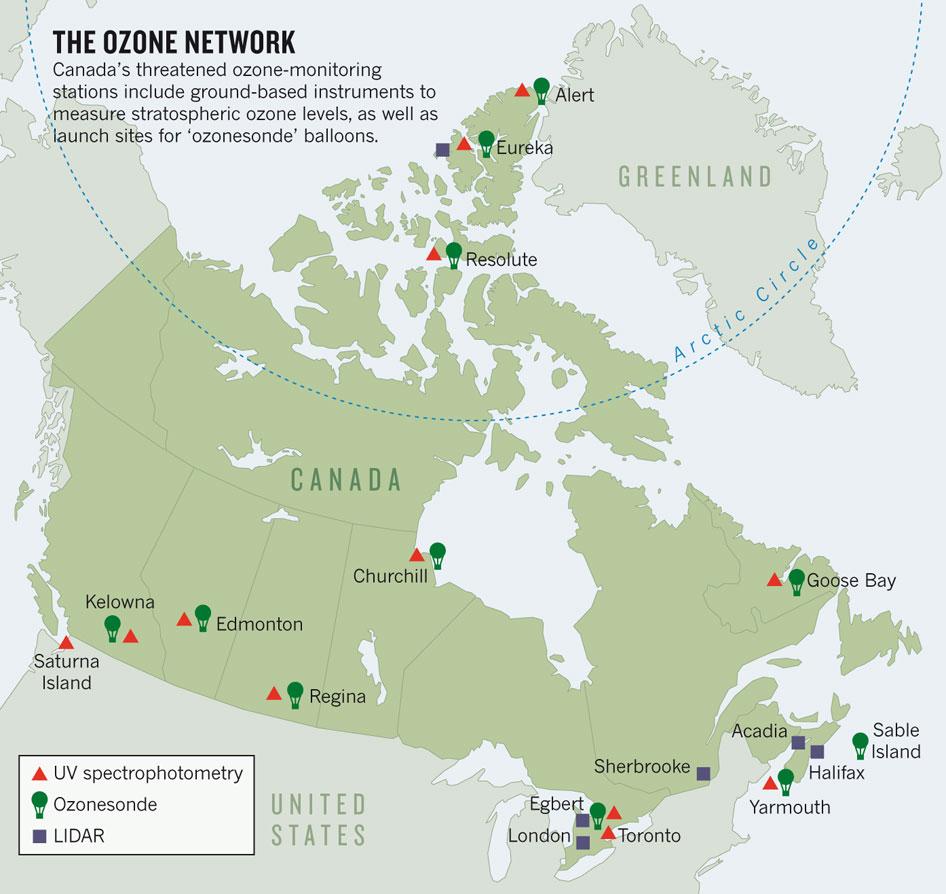
A key source of information about the health of the ozone layer above the Arctic looks set to be choked off.
In a year that saw the first genuine 'ozone hole' appear in the Northern Hemisphere, atmospheric scientists say they are shocked to learn that Environment Canada, the country's environment agency, has decided to drastically reduce its ozone science and monitoring programme.
Its network of monitoring stations provides about one-third of the Arctic's ozone measurements and this year contributed key data showing unprecedented depletion of stratospheric ozone over the Arctic. With regular in situ measurements going back to 1966, Canada also holds the longest-running record of atmospheric ozone levels in the world - an archive that is also threatened.
The Canadian observation network comprises 17 stations - from London, Ontario, in the south to Alert in the high Arctic - which use several techniques to measure ozone (see 'The ozone network'). But atmospheric scientists and research institutes around the world, including Canada, Britain, Switzerland and Germany, have been told, informally, that the network will be shut down as early as this coming winter. This will be the end of in situ ozone measurements, including those made by balloons launched at least once a week from 11 of the stations. "This is devastating for the whole field," says Tom Duck, who conducts atmospheric research at Dalhousie University in Halifax, Nova Scotia.
Environment Canada's ozone and radiation research group will also be substantially reduced as a result of staff cuts driven by financial constraints. A spokesman for the agency refused to confirm the cuts, saying merely that all government-funded programmes are currently being reviewed.
"This is a sad and abrupt end of many years of very successful collaboration," says Markus Rex, an ozone researcher at the Alfred Wegener Institute for Polar and Marine Research in Potsdam, Germany, who has previously worked with the Canadian network in international, Arctic-wide ozone measurement campaigns, dubbed Match. "I'm worried that the cuts will lead to an erosion of the Montreal Protocol, which obliges Arctic countries to monitor the ozone layer and maintain scientific ozone research."
The blow comes at a crucial time for monitoring efforts. In March, scientists reported that 40% of stratospheric ozone over the Arctic had been destroyed - the highest ozone loss previously measured was 30% in 2005. The record loss was due mainly to exceptionally low temperatures last winter in the Arctic stratosphere, which help to form ice particles at an altitude of around 18 - 25 kilometres. These particles host the chemical reactions by which long-lived chlorofluorocarbons catalyse the breakdown of ozone.
Although ozone loss is usually more pronounced above cooler Antarctica, ozone-depleted Arctic air can reach populated areas more easily. Because ozone helps to block potentially harmful ultraviolet radiation from the Sun, its depletion could raise the risk of health problems such as skin cancer in northern populations.
"Canada has been a linchpin of Arctic ozone observation," says Neil Harris, an atmospheric chemist at the University of Cambridge, UK, who heads the European Ozone Research Coordinating Unit. "It has contributed very substantial data to research that allows us to be diagnostic about what's happening in the Arctic stratosphere. If we were to lose one-third of our monitoring capability in the Arctic the overall loss in scientific value will be much greater."
Satellite observations are no substitute for in situ ozone measurements, adds Johannes Staehelin, an atmosphere researcher at the Swiss Federal Institute of Technology in Zurich who chairs the World Meteorological Organization's ozone science advisory group. Indeed, in situ data are essential for calibrating and validating measurements by satellites such as NASA's Aura and the European Space Agency's Envisat.
Staehelin adds that the Canadian agency has said it will no longer host the Toronto-based World Ozone and Ultraviolet Radiation Data Centre, an archive of data collected over several decades and used intensively by atmospheric scientists around the world. "It appears that the management at Environment Canada was not fully aware of the consequences of its decision," says Staehelin. Last month, the agency notified its staff that a total of 776 jobs will be cut.
Canadian environmental research has already been hit hard by the looming closure of the Canadian Foundation for Climate and Atmospheric Sciences, which provides the majority of funds for climate and atmospheric science in the country. The charitable foundation has received no federal funding since 2003, and is expected to close next year.
"The funding crisis in this country is really hammering our ability to observe and protect the environment of Canada," says Duck. "I have already lost most of my group because I just can't pay them any more. If help doesn't come soon, many others will shut up shop."




if the ozone is gone, then there's nothing there to study.
i would like to know what they do to 'help' besides watch the ozone deplete and tell everyone about it, hence no funding...
i also wonder if our magnetic field can 'escape' through the hole in the ozone ' referring to electric universe.